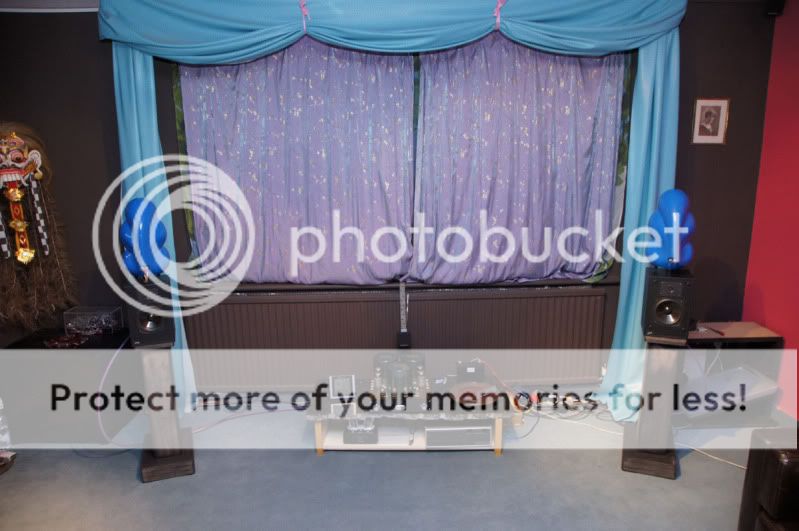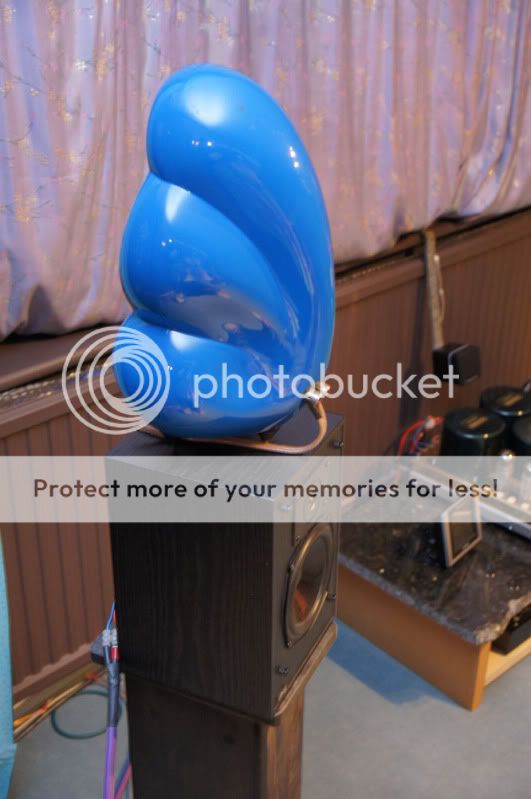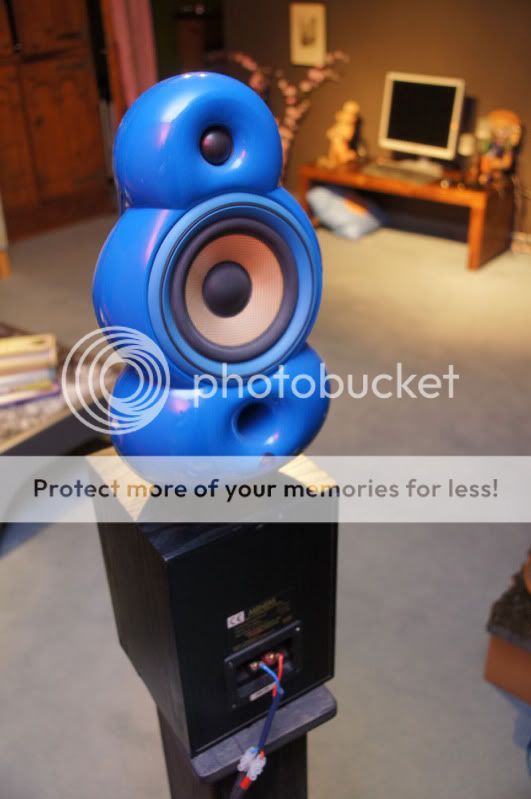I removed some of the stuffing from when the picture was taken. I started with 1/2 pound per cuft but ended up with some where around 1/4 pound per cu ft. (estimate)
I would recommend going to WalMart and buying poly pillow stuffing it's cheap and seems to work as well as acousta-stuff, at least untill you get an idea on stuffing quanity.
I would recommend going to WalMart and buying poly pillow stuffing it's cheap and seems to work as well as acousta-stuff, at least untill you get an idea on stuffing quanity.
Just a thought and wonder if anyone has considered putting another driver on the back and running these as bi-polar ?
Fine as long as you double the cross-section and ports. Also a good idea to make it wider than deep (i figure a 3:1 is a good compromise)
dave
I have no idea what putting another driver on the back side would do to a mass loaded transmission line. If I were going to try this I think I would just do a bass reflex design with the two drivers. Interesting idea let us know the results if you try it. Planet10 may more insight to this type of design.
Fine as long as you double the cross-section and ports. Also a good idea to make it wider than deep (i figure a 3:1 is a good compromise)
dave
Ok Dave, so basically means different cabinets. Have ordered the wood for these ones so will see how that goes for now.
I use to have a little known bi-polars - Musical Fidelity MC6s, about the same size as Jim's but with about six or eight drivers of which three were on the back. I was such a fool to ever get rid of them and have been craving that expansive sound ever since...
Fine as long as you double the cross-section and ports. Also a good idea to make it wider than deep (i figure a 3:1 is a good compromise)
dave
Hi Dave,
Come to the conclusion that doubling up the size of those cabs will be too big for my living room, plus at 300litres is huge. I have a drop down screen for the cinema so can't place them closer. But def want to go the bipolar / dipol route.
So last night set up a poorman's bipolar setup with whatever came to hand and bingo: glorious ! Wide open and still keeping focus.
How about me making four of the recommended seas cabinets for the FA22RCZs and just stacking them with the bottom one facing backwards ?!



You may won't to think about this 2 drivers wired in series, I would assume one in front one in back wired out of phase in a reflex enclosure rather than MLTL. The dimensions would be (outside dimensions) 45.5inX12inX15.5in HXWXD mount the front driver so the center is around ear height when seated (34in to 35in). Two ports of 3in diameter by 8in length will give you a F3 of 30.55Hz, but cone excursion may limit power input.
If you have a sub then a better alignment may be two 3in dia. by 4in long which will give you a F3 38.8 Hz may still run into excursion problems at around 50 watts but it will be at around 108 db (this is loud) so probably not a problem. You will probably still need a zobel at least on the front driver such as inductor with resistor in parallel. Look at application note for Fa22RCZ (google). Those are cool blue speakers did you build them?
If you have a sub then a better alignment may be two 3in dia. by 4in long which will give you a F3 38.8 Hz may still run into excursion problems at around 50 watts but it will be at around 108 db (this is loud) so probably not a problem. You will probably still need a zobel at least on the front driver such as inductor with resistor in parallel. Look at application note for Fa22RCZ (google). Those are cool blue speakers did you build them?
Thanks Jim,
The blue speakers are Blueroom minipods which I use on my desk, but I took off the skinny legs and replaced them with cones:
Blueroom Loudspeakers Minipod (Carnaby Blue) - Speakers & Speaker Systems - CNET Archive
With bipole is there a preferred position for the rear facing driver do you know ? Some say not to place them behind one another. Putting it down low would enforce the bass and up high would be good for the 'spacial' feeling perhaps ?
The blue speakers are Blueroom minipods which I use on my desk, but I took off the skinny legs and replaced them with cones:
Blueroom Loudspeakers Minipod (Carnaby Blue) - Speakers & Speaker Systems - CNET Archive
With bipole is there a preferred position for the rear facing driver do you know ? Some say not to place them behind one another. Putting it down low would enforce the bass and up high would be good for the 'spacial' feeling perhaps ?
I have no idea I guess I would split the difference and put the back side driver lower than the front but above center line of the enclosure. If you made the back removable then you can flip the back from top to bottom and see which works the best.
Also I'm not sure if the two should be in phase or out of phase but that would be easy to change and see which works the best. The question is what happens when the two wave fronts sum within the listening area.
Also I'm not sure if the two should be in phase or out of phase but that would be easy to change and see which works the best. The question is what happens when the two wave fronts sum within the listening area.
Jim,
-the dimensions you give for the outside: What thickness wood to use ? Assume three quarter inch, but best check to make sure
-Would rather not use the sub as that is hooked up to my AV amp, so the F3 of 30.55hz would be good. Not bad depth from a couple of 8" full ranges !
- Check this out, knows his stuff:
http://www.audiocircle.com/index.php?topic=56877.msg499566#msg499566
-the dimensions you give for the outside: What thickness wood to use ? Assume three quarter inch, but best check to make sure
-Would rather not use the sub as that is hooked up to my AV amp, so the F3 of 30.55hz would be good. Not bad depth from a couple of 8" full ranges !
- Check this out, knows his stuff:
http://www.audiocircle.com/index.php?topic=56877.msg499566#msg499566
The dimensions were based upon 3/4in thickness. so if you subtract 1.5in from all dimensions then you will get internal dim. I looked at the audiocircle post very interesting, so you could let the side dimension be front / back or redo the dimensions to give a even wider front / back just so the volume is the same. Also if you use extensive bracing you need to bump the internal volume a little. In any case be sure to use damping on the cabinet walls.
Thinking about your comment of wanting response down into the 30hz, I went back and looked at the cabinet dimensions again based upon my experience with this driver.
The original dimensions will give you response as noted for one driver only at around 3.3cu ft enclosure, for two drivers we would need to basically double the volume. So a possible size for 30 to 35 hz 45.5in X 21in X 15in with two 3in dia. by 4in port. A better approach may be let me know what size enclosure would work for you and I can determine the response for a given size and ports. The above has the 21 in dim as the front.
The original dimensions will give you response as noted for one driver only at around 3.3cu ft enclosure, for two drivers we would need to basically double the volume. So a possible size for 30 to 35 hz 45.5in X 21in X 15in with two 3in dia. by 4in port. A better approach may be let me know what size enclosure would work for you and I can determine the response for a given size and ports. The above has the 21 in dim as the front.
I thought you might wish to have some technical background on bipolar speaker design. Offset bipolar speakers can offer significant advantages in addressing room integration issues. Duke LeJeune of AudioKinesis has written a white paper that relates some of the aspects of offset bipolar design as you can read here:
The Controlled-Pattern Offset Bipole Loudspeaker, by Duke Lejeune | Hifi Zine
Duke also has a commerical loudspeaker that incorporates his thinking on offset bipolar design on his website:
AudioKinesis - sound that moves you
The Controlled-Pattern Offset Bipole Loudspeaker, by Duke Lejeune | Hifi Zine
Duke also has a commerical loudspeaker that incorporates his thinking on offset bipolar design on his website:
AudioKinesis - sound that moves you
Thinking about your comment of wanting response down into the 30hz, I went back and looked at the cabinet dimensions again based upon my experience with this driver.
The original dimensions will give you response as noted for one driver only at around 3.3cu ft enclosure, for two drivers we would need to basically double the volume. So a possible size for 30 to 35 hz 45.5in X 21in X 15in with two 3in dia. by 4in port. A better approach may be let me know what size enclosure would work for you and I can determine the response for a given size and ports. The above has the 21 in dim as the front.
Have you seen this cab design Jim ?
http://www.seas.no/images/stories/exotic/pdf_datasheet/kt_3-10_exotic.pdf
Its for the more expensive, the F8, but same internal volume. I could make four of these cabs and stack and turn them so to speak. BTW wish I knew how to get a PDF translated..
Duke also has a commerical loudspeaker that incorporates his thinking on offset bipolar design on his website:
AudioKinesis - sound that moves you
Nice, but way out of reach of my empty pockets...
Thinking about your comment of wanting response down into the 30hz, I went back and looked at the cabinet dimensions again based upon my experience with this driver.
The original dimensions will give you response as noted for one driver only at around 3.3cu ft enclosure, for two drivers we would need to basically double the volume. So a possible size for 30 to 35 hz 45.5in X 21in X 15in with two 3in dia. by 4in port. A better approach may be let me know what size enclosure would work for you and I can determine the response for a given size and ports. The above has the 21 in dim as the front.
Problem with 21inch wide cabs is that they might have to be placed too far apart as unable to move them closer together due to clearance needed for the drop down screen for the projector. The Klang+Ton-Projekt has a more suitable 17inch width and by accident conformers to the 3 to 1 bipolar requirement more or less. I can't read German (I think its German ?!) but they claim a reasonable 38.2Hz
The klang+ton has a resonate frequency of 38hz the 3db point is around 50hz. If you a 3db point of 50hz then the enclosure can be a lot smaller. Once again if you have a sub then that may be the way to go. Also after reading the paper on bipole speakers one of the main design tenets is controlled pattern using a constant directivity horn or waveguide.
- Status
- This old topic is closed. If you want to reopen this topic, contact a moderator using the "Report Post" button.
- Home
- Loudspeakers
- Full Range
- SEAS FA22RCZ MLTL